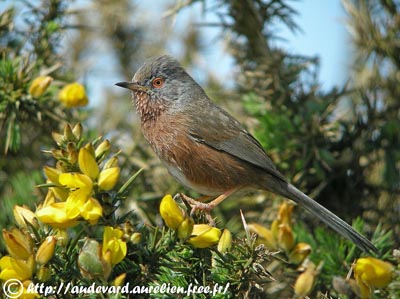
Dartford Warbler
Sylvia undata
Passeriforme Order – Sylvidae Family
BIOMETRICS :
Length: 13 cm
Weight: 9-12 g
DESCRIPTION:
Dartford Warbler was first described from Bexleyheath, near Dartford in NW Kent in 1773, but the population is now extinct in this area since the early 20th century.
It is a small warbler with short wings and long tail.

Adult male has dark slaty-brown upperparts, with browner wings. Tail is dark brown with grey-edged feathers and whitish-edged outer rectrices. Head and mantle are rather greyer.
Underparts are dark vinous-red on chin, throat, breast and flanks. Belly is whitish.
The head has grey forehead, crown, sides and nape. The blackish thin bill has pinkish-yellow base of lower mandible. Eyes are red-orange with conspicuous red eye-ring. Legs and feet are bright yellow-orange.
We can see numerous fine white spots on chin and throat. But there are numerous variations of plumage in this species.

Adult female has duller and brownish plumage. Upperparts are dusky. On the underparts, breast is duller and more pinkish than vinous-red. The white spotting on throat is less visible.

Juvenile resembles female with dark greyish-brown upperparts, and paler underparts with whitish belly and whitish spots on throat.
We can find five subspecies:
S.u. aremorica
S.u. dartfordiensis, from Britain and northern France. It is browner on upperparts.
S.u. naevalbens
S.u. toni, from North Africa. It is slightly paler overall.
S.u. undata.
VOICE: SOUNDS BY XENO-CANTO
Dartford Warbler’s typical call is a nasal « chirr » as alarm call, while the bird moves among vegetation and comes to open in order to look at potential intruder. We can also hear a short “tuk” often repeated when excited.
The song is a scratchy, chattering phrase, uttered from an exposed perch and all year round.

HABITAT:
Dartford Warbler, in the northern parts of the range, frequents heathlands and sheltered coastal slopes with scrub and scattered trees.
Southwards, this species is found in open bushy areas with some trees, in rocky hillsides with thorny maquis, and open woodlands of pine trees with bushy undergrowth.
RANGE:
Dartford Warbler is found from southern Britain, western France, and southern Europe to Italy and Sicily, and North Africa (where it frequents low sparse scrub in semi-desert).
BEHAVIOUR:
Dartford Warbler feeds mainly on insects during summer, but it also consumes berries and seeds during winter.
This small bird forages within cover of low scrub. It is very shy and secretive. But when the sun shines, the male sallies up to two metres in the air while it utters harsh calls during a flight display. At this moment, it has raised crown feathers and the long tail is cocked high and switched from side to side.
In the early April, male performs flight displays and sings all the day. After the flight, it alights on exposed perch and fluffs its head feathers, giving an appearance of large head for so small bird.

Dartford Warbler is sedentary with some post-breeding movements. Although being very vulnerable to hard winters in northern parts of the range, this species does not migrate.
FLIGHT:
Dartford Warbler flits low from the ground, performing a weak undulating flight on short whirring wings, with cocked tail on landing.

REPRODUCTION:
Breeding season occurs in spring, in the early April.
The male builds several nests which are flimsy and loose structures. But the nest used for breeding is made by female. It is placed close to the ground, between 25 and 130 cm above the ground. Nest is made with dried grasses, moss, wool, down and spider webs. Interior is lined with soft materials such as fine grasses, wool and feathers.
Female lays 3-4 whitish or pale greenish eggs with fine darker spots, usually in the early May. Incubation by female (sometimes by male for a short time) lasts about 12 to 13 days.
Altricial chicks are cared by both adults and fed with insects. They leave the nest 12 to 13 days after hatching, sometimes sooner if they are disturbed or if the weather is very warm.
This species produces two broods per season, sometimes three.
DIET:
Dartford Warbler is mainly insectivorous, foraging for several kinds of Coleoptera, Lepidoptera and Diptera and their larvae. During winter, it also feeds on spiders, seeds and berries.

PROTECTION / THERATS / STATUS:
Dartford Warbler is very vulnerable to hard winters in northern parts of its range. This species suffered declines and it is still threatened by human developments and habitat loss due to agriculture expansion.
Dartford Warbler is classified as near threatened since 2008.
Fr: Fauvette pitchou
All : Provencegrasmücke
Esp : Corruca de Cola Larga
Ital: Magnanina
Nd: Provençaalse Grasmus
Sd: Provencesångare
Photographs by Aurélien Audevard
His website : OUESSANT DIGISCOPING
Photographs by Didier Buysse
His website: Vision d’Oiseaux
Photo of juvenile and text by Nicole Bouglouan
Sources :
L’ENCYCLOPEDIE MONDIALE DES OISEAUX - Dr Christopher M. Perrins - BORDAS - ISBN: 2040185607
THE COMPLETE BOOK OF BRITISH BIRDS – Written by “Royal Society for the Protection of Birds” experts - Préface de Magnus Magnusson - Michael Cady- Rob Hume Editors - ISBN: 0749509112
THE HANDBOOK OF BIRD IDENTIFICATION FOR EUROPE AND THE WESTERN PALEARCTIC by Mark Beaman, Steve Madge - C.Helm - ISBN: 0713639601
Pájaros de España (JL Beamonte)
Wikipedia (Wikipedia, The Free Encyclopedia)